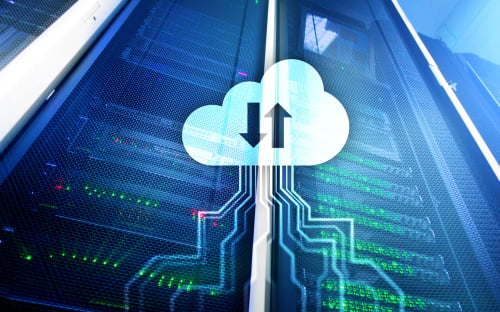
Your business runs on IT and chances are if your systems are down, your business is down. Have you contemplated the most common reasons for data loss and whether your strategy can protect you in the event of natural disaster, hardware failure, fire, ransomware, human error or theft? Depending on the reason for your outage, you may experience data loss and need to leverage your backups to recover. Are you confident in your backup and recovery strategy?
One of the simplest tests you can do to assess your backup strategy is to see how you stack up against the 3-2-1 best practices for backups. This requires that you have 3 copies of your data on 2 different media with 1 of them being offsite. When I visit companies and talk to them about their backup strategies, very few are meeting the 3-2-1 best practices.
Magnetic Tape: The Old Standby
It’s safe to say that most companies we talk to are using magnetic tape as their backup solution. The technology has been around for years, their solution was implemented long ago, it’s relatively inexpensive to maintain and once it’s setup anyone can change tapes and keep it running. And while you can’t argue with “easy” it’s a solution full of short comings.
For starters magnetic tape is slow for performing backups and slow for restoring data. This means that your system will be down longer each night while you perform backups and in the event a recovery is required it will take longer to restore the data. With magnetic tape it is also slow to find data on the tape and difficult to recover specific or individual files.
The team responsible for backups further exacerbates the problems with magnetic tape and the risks by not storing them in ideal conditions (temperature and humidity controlled), reusing tapes for years on end and simply trusting that the data will be there when needed versus testing the recovery process.
While this is “the old standby” approach, there are better options out there.
Cloud Backups: Getting Your Data Offsite
One of the biggest mistakes I see companies making with their backup solution is not getting their backup to a secure, offsite location. It is not uncommon to see backup tapes stored in the same room or building as the production systems.
The cloud provides companies with an easily accessible solution for getting that backup data offsite. The IBM i 2022 Marketplace report indicated that 11 percent of companies plan to recover from a disaster with cloud backups. This low number seems to hold true with the companies I talk to as I seldom run into companies backing up IBM Power Systems to the cloud.
With this solution, you will typically install an agent on your LPAR that creates a local backup copy and then pushes that copy offsite per your schedule. This offsite copy can be stored at a single location, or multiple locations depending on what services your provider offers. So, depending on how you deploy your cloud backup solution, it could enable you to meet the 3-2-1 best practices backup standard.
One word of caution as you start looking at solutions that get your data offsite, investigate whether you will have a local backup copy or not. While incremental backups to the cloud may not take long to execute, if you needed to perform a full recovery of terabytes of data it might take longer than expected. Test the restore process so you know how long it takes and if you will be able to meet your recovery time objective.
Virtual Tape Libraries (VTL): A Big Improvement Over Physical Tape
For those not familiar with VTLs, a VTL is simply a disk-based backup system that emulates physical tapes. Your Power System will “see” the VTL like it does a traditional tape backup system. When we talk to customers that want to move away from traditional magnetic tape backup, this is typically the route we discuss. There are several benefits to making the move to a VTL.
One of first benefits companies see is the fact that the VTL will provide a significantly faster backup and recovery process than magnetic tape, reducing system downtime for backups and speeding your recovery in the event of a disaster. The digital format of the VTL also provides easy access to individual files for restoration.
Another benefit of the VTL is the ease with which you can create a second copy of your data (an immutable copy) at an offsite location. This can be accomplished by either purchasing a second VTL and locating it at one of your remote locations or by partnering with a service provider that offers VTL replication services. With the service provider model, you replicate your data to their VTL and instantly have an offsite copy without the expense of a second VTL. If the upfront cost of a VTL isn’t in your budget, some service providers will offer a VTL Backup and replication solution that includes all the necessary hardware and storage at a fixed monthly fee.
Replication Software: Improve Your Recovery
Performing replication on its own does not replace your backup solution but it opens the door to some additional backup options. There are several well-known replication solutions available in the market and they are all designed to enable you to keep two copies of your data in sync in near real time. When paired with a high availability (HA) infrastructure, these solutions enable you to meet a very low recovery time objective (RTO) and recover point objective (RPO).
The backup option that comes about with this replication solution is in leveraging your replica copy to produce your backups. Racksquared has a few customers that have opted to utilize Rocket iCluster to replicate their data to an HA environment in our data center and then we produce backups from that replica. In this scenario the customer has four copies of their data in 3 separate locations. Their production data is at their location, a replica copy is at our primary data center, a backup copy is at our primary data center and a backup copy is at our secondary data center.
Cloud Hosting: All In One Backup Solution
To position Power Systems in the cloud as a backup solution is a bit of a stretch but if you have been considering how to improve the backup, recovery and overall resiliency of your infrastructure a cloud solution can do just that. When you migrate your LPAR and data to the cloud, your service provider is able to dramatically improve your ability to recover in the event of a disaster.
From a hardware perspective, service providers have multiple hosts at multiple locations and can design a solution that will allow you to meet your specific RTO and RPO. For customers that don’t need a guaranteed recovery time, there are options that just include a “best efforts” approach. The next step up is reserved infrastructure in which case you pay a fee to insure there will be capacity available to you when you need it. At the top of the value chain is an HA system that is configured to your specifications and is ready to be turned up at a moment’s notice.
Regarding your data and backups, your provider can develop a solution that meets your specific needs. At Racksquared Data Centers, our standard Power Systems cloud hosting solution includes four copies of your data in two separate data centers. Your production data is stored on a highly resilient storage area network (SAN) that is replicated in near real time to another SAN in our secondary data center. This gives you that low recovery time and recovery point that we talked about above. Each day your data is backed up to a VTL, deduped and compressed before being replicated to a second VTL at the secondary data center.
Backup and Recovery: A Solution To Meet Your Needs
Backup and recovery solutions are not a one size fits all proposition and that’s what Racksquared Data Centers works with each customer to design a solution to meet their specific needs. If you would like to learn more about how we can help protect your business, check out our IBM Power Solutions on the web, see some of our client success stories or contact us to schedule a call.

